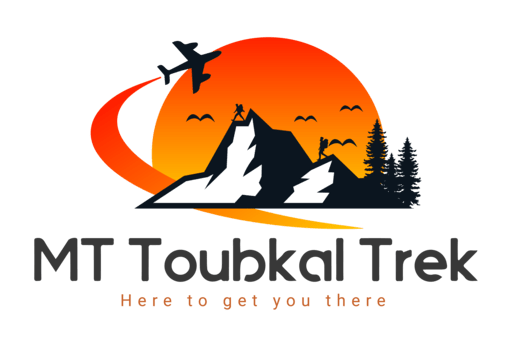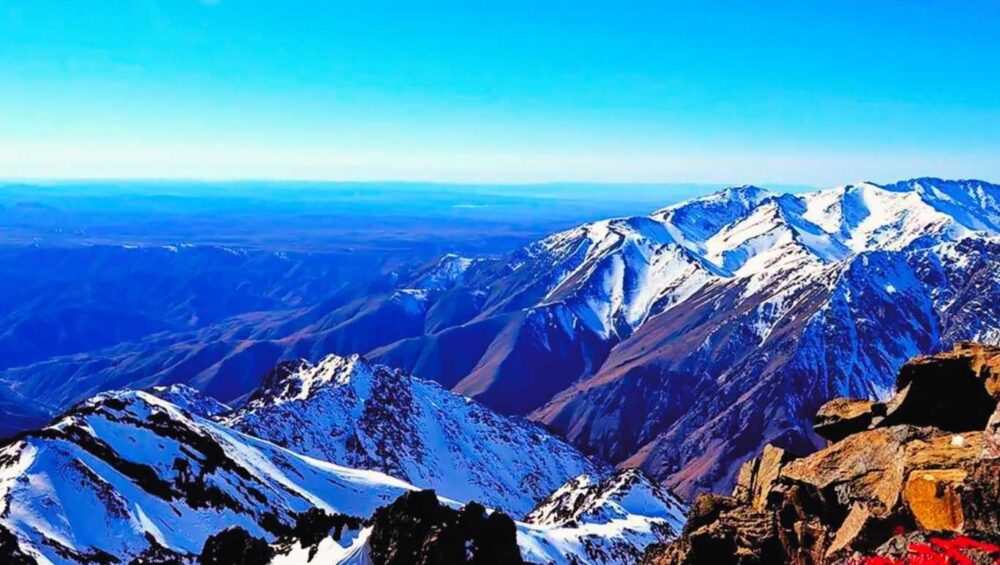Morocco, a land of vibrant souks, ancient medinas, and endless desert vistas, holds a majestic secret in its heart: the High Atlas Mountains. Soaring to a breathtaking 4,167 meters, Jebel Toubkal, the highest peak in North Africa, beckons adventurers and offers an unforgettable challenge. For those seeking an exhilarating blend of physical endeavor, stunning natural beauty, and rich cultural immersion, the Toubkal trek is an absolute must.
The Journey Begins: Marrakech to Imlil, the Gateway to the Atlas
Your adventure typically begins in the captivating city of Marrakech. From the bustling Djemaa el-Fna square, a roughly 1.5 to 2-hour drive transports you into the serene embrace of the Atlas foothills, specifically to the charming village of Imlil (at 1,740m). Imlil, nestled amidst terraced fields and the gentle murmur of mountain streams, serves as the primary gateway for any Toubkal trek.
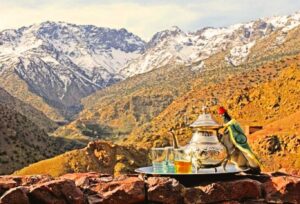
Here, the air is crisper, the pace is slower, and the hospitality of the indigenous Berber people is immediately apparent. Before embarking on your Toubkal trek, take a moment to explore Imlil. Wander through its narrow lanes, observe local life, and perhaps enjoy a traditional mint tea at a guesthouse. There are no ATMs in Imlil, so ensure you have sufficient Moroccan Dirhams for purchases and tips. You’ll also encounter your local team here: experienced, certified mountain guides and trusty muleteers who will be your companions and support throughout your journey. Hiring local guides and porters not only ensures a safer trek but also directly supports the local economy of these mountain communities, whose lives are intrinsically linked to the rhythm of the mountains and the trekkers they welcome.
The Toubkal Trek: A Path Through Time and Terrain
The Toubkal trek is not merely a climb; it’s a journey through landscapes that shift from verdant valleys to stark, rocky ascents, offering a profound sense of connection to nature and a glimpse into a way of life largely unchanged for centuries.
Day 1: Imlil to Toubkal Refuge (approx. 5-6 hours trekking)
From Imlil, the trail leads upwards, winding through the Aït Mizane Valley. You’ll pass through villages like Aremd, with its traditional mud houses and terraced fields, a testament to the Berbers’ ingenuity in cultivating this challenging terrain. The path is often a mule track, making the journey more manageable as mules carry your heavier gear and supplies. Along the way, you’ll encounter the Sidi Chamarouch shrine, a pre-Islamic pilgrimage site by a small waterfall. This spot offers a welcome break before the steeper ascent continues.
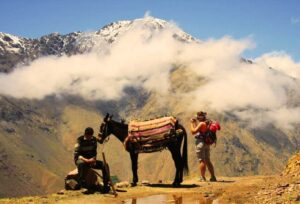
The trek gradually gains elevation, leading you to the Neltner Refuge (at 3,207m), the primary base camp for summit attempts. This stone-built mountain hut, while basic, provides a warm and communal atmosphere, bringing together trekkers from all corners of the globe. Spending the night at the refuge is crucial for acclimatization, allowing your body to adjust to the thinning air. This is a vital step in preventing altitude sickness, which can manifest as headaches, nausea, or dizziness. Hydration is key, so remember to drink plenty of water.
Day 2: Summit Day – Toubkal Peak and Return to Refuge (approx. 6-7 hours trekking)
The summit push for the Toubkal trek typically begins before dawn, often around 4:00 or 5:00 a.m. This early start allows trekkers to reach the summit for sunrise, offering truly unparalleled panoramic views, and to avoid the strong afternoon sun. The ascent is challenging, involving a sustained hike over rocky, scree-laden terrain. While not technically demanding, good physical fitness and mental fortitude are essential. Trekking poles are highly recommended for stability and to reduce strain on your knees during both ascent and descent.
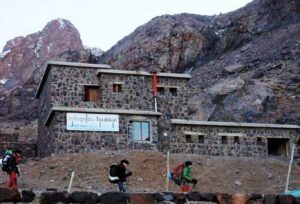
As you zig-zag your way up, the landscape becomes increasingly dramatic. From the saddle between Toubkal West and the main peak, you might catch your first glimpse of the Sahara Desert stretching out to the horizon. The final push to the pyramid-shaped summit is steep, requiring determination, but the reward is immense. Standing atop Jebel Toubkal, the roof of North Africa, you’ll be treated to a 360-degree vista of the snow-capped High Atlas, the vast plains towards Marrakech, and to the south, the beginnings of the Anti-Atlas and the Sahara. It’s a moment of triumph and awe that makes every challenging step of the Toubkal trek worthwhile. After soaking in the views, the descent back to the Neltner Refuge is long and can be tiring, but the sense of accomplishment remains. You’ll spend another night at the refuge.
Day 3: Return to Imlil and Marrakech (approx. 4-5 hours trekking + 1.5 hours drive)
After a well-deserved rest and breakfast at the refuge, you begin your descent back to Imlil, retracing your steps through the stunning mountain scenery. The downhill journey is often quicker, allowing more time to appreciate the subtle details of the landscape and the rhythm of Berber life. Upon reaching Imlil, a hearty lunch at a guesthouse awaits, a perfect end to your trekking experience. From Imlil, private or shared taxis will transport you back to the vibrant energy of Marrakech, leaving you with memories of an epic Toubkal trek that will last a lifetime.
Best Time for Your Toubkal Trek
The ideal time for a Toubkal trek largely depends on your preference for conditions.
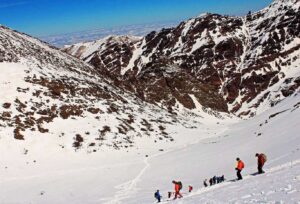
- Spring (April-May) and Autumn (September-October): These are generally considered the best seasons. Temperatures are mild and pleasant, avoiding the extremes of summer heat and winter cold. There’s often a beautiful scattering of wildflowers in spring, and the autumn brings clear skies and comfortable trekking conditions.
- Summer (June-August): While feasible, summer can be very hot, especially in Marrakech. The mountains offer some respite, but be prepared for intense sun and carry plenty of water. Sun hats and high SPF sunscreen are crucial.
- Winter (October-April): For experienced trekkers seeking a more challenging adventure, a winter Toubkal trek offers breathtaking snowy landscapes. However, it requires specialized gear like crampons and ice axes (which can be hired in Imlil) and experience with snow and ice conditions. Temperatures at the summit can drop to -10°C or lower.
Essential Preparations for Your Toubkal Trek
A successful and enjoyable Toubkal trek requires careful preparation:
- Physical Fitness: While not a technical climb, the Toubkal trek is physically demanding. Regular cardio exercises (running, cycling, swimming) and strength training focusing on legs and core are highly recommended. Include long walks with a backpack to build endurance.
- Gear: Layering is essential due to temperature variations. Pack moisture-wicking base layers, warm mid-layers (fleece, insulated jacket), a waterproof and windproof outer shell, sturdy well-broken-in hiking boots with good ankle support, warm hat, sun hat, gloves (windproof and insulated), sunglasses (Category 4 lenses are ideal), and a headlamp with extra batteries. A small, quick-drying towel, toiletries, and a basic first-aid kit with blister plasters and pain relievers are also crucial.
- Altitude Acclimatization: Give your body time to adjust. The overnight stay at the refuge is vital. Pace yourself on the ascent, stay well-hydrated, and avoid alcohol and excessive caffeine. If symptoms of altitude sickness worsen, descend immediately.
- Guide and Porters: It is mandatory to hire a certified mountain guide for the Toubkal trek. They are invaluable for navigation, safety, and cultural insights. Muleteers and their mules will carry your main luggage, allowing you to carry a lighter daypack.
- Cultural Sensitivity: The Toubkal region is home to the welcoming Berber people. Dress modestly, covering shoulders and knees. Use your right hand for transactions, and always ask for permission before taking photos of people, especially women. Be mindful of showing off wealth, as it can create discomfort.
- Permits: While formal permits aren’t usually a separate item for trekkers with a guided tour, your guide will handle any necessary park fees or registrations. Always carry your passport.
Beyond the Summit: The Enduring Impact of the Toubkal Trek
The Toubkal trek offers more than just a physical challenge; it’s an opportunity for profound cultural exchange. Engaging with your Berber guide and muleteers, sharing mint tea in mountain guesthouses, and witnessing the simple yet resilient life of the mountain communities adds an immeasurable depth to the experience. Supporting local initiatives and guides contributes directly to the sustainable development of this region, allowing future generations to experience the magic of the High Atlas.
As you descend from the majestic heights of Toubkal, you carry with you not just the exhilaration of conquering a peak, but also a deeper understanding of Morocco’s diverse landscapes and the enduring spirit of its people. The Toubkal trek is an adventure for the body, a feast for the eyes, and a journey for the soul, leaving an indelible mark on every traveler who answers its call.
